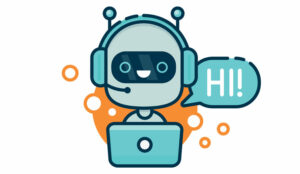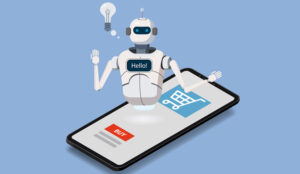Designing an AI chatbot is a tricky exercise that cannot be improvised. Following a set of best practices will help you avoid common mistakes and pitfalls that other companies have encountered.
This will ensure that you create a bot that is helpful, engaging, and meets customers’ expectations every time. We have compiled the top 8 chatbot best practices when it comes to designing state-of-the-art conversational experiences. Use these to make your chatbot a success.
Chatbot Best Practice #1: Set a Goal for Your Chatbot
As obvious as it may seem, this is the number one chatbot best practice to keep in mind when starting to design a conversational agent. You can create a bot for almost anything nowadays, so setting a clear goal for yours and outlining what it’s supposed to do, right from the beginning, will prevent you from getting carried away.
Defining what can be automated is a good place to start, but remember to always keep your users’ needs in mind when doing so.
It can be as simple as answering users’ queries, or more complex, like allowing employees to request annual leave, but your chatbot has to be user-centric and help solve their problems if you want it to be successful.
Chatbot Best Practice #2: Give Your Chatbot a Personality
The second important point that you should think about when creating your conversational chatbot is to ensure that it doesn’t sound like a robot. That means giving it a personality and a tone of voice that’s aligned with your brand’s values.
This is a tricky exercise as a lack of personality will make your chatbot sound dull and uninteresting, but on the other hand, too much personality can also ruin an otherwise well-designed experience.
Ask yourself these questions to help you find the right balance:
- How would your target audience speak? A chatbot often mirrors the personality of its audience by writing in the style they speak.
- What’s the name of your chatbot? It can be straightforward, such as your brand’s name followed by ‘bot’ or ‘chatbot’, or a play on words, for example.
- Does it have a gender and a visual representation? Inbenta gives you the option to choose from a vast gallery of avatars so that you can find the one that will become the perfect representation of your brand.
Chatbot Best Practice #3: Introduce Your Chatbot and Set Expectations
As mentioned at the beginning of this article, you have to set a goal for your chatbot. Now that you know what your bot is designed to do, you have to clearly communicate that to your users. Your welcome message is the perfect place to introduce your bot and list all of its capabilities.
By being upfront about functionalities, as well as limitations, you will manage the users’ expectations and prevent frustration and disappointment.
Chatbot Best Practice #4: Break Up the Information Into Small Chunks
A well-designed bot can present users with lots of informative and interesting content. That’s great, but don’t forget to break up the information when pushing useful and engaging material. That means sending multiple short messages rather than a long one.
Huge blocks of text are difficult to read and may frustrate, discourage and/or overwhelm users. By using short messages, your bot will provide a better user experience and also mimic the flow of human messaging.
When developing your chatbot with Inbenta, you also have the option to use a side-bubble where you can develop more in-depth content, which is another great way of breaking up the information.
Chatbot Best Practice #5: Test, Monitor, Tune
Going through an alpha and beta testing phase before releasing your chatbot is quite obvious, but you have to keep on monitoring results even after going live.
It is surprising to see how many companies forget about this simple chatbot best practice and forget about their bot once it’s been developed.
Inbenta’s Workspace will provide you with lots of data and analytics to help you analyse your bot performance, perform a gap analysis by detecting questions that did not get an answer, or the ones that got an answer but were not viewed by the user.
Chatbot Best Practice #6: Request User Feedback
Giving the option for users to rate answers – using a thumbs-up or down button for example – is an easy way to gather feedback.
You can also offer users the option to provide written feedback when a negative mark is given so that they can provide more in-depth explanations of why interactions with your bot were not satisfactory.
Ratings and written feedback can be very helpful and instructive. They give you the opportunity to detect gaps in your knowledge base or ways to use your bot or formulate questions that you did not think of.
Chatbot Best Practice #7: Detect Frustration and Hand Off to a Human
No matter how good or well-designed your chatbot is, every bot has its limitations. These limitations will sometimes create frustration, so that’s why you need a technology that can detect your users’ emotions by analysing their tone and the type of language they are using.
Inbenta’s NLP technology and intent detection can do exactly that and provide an option to escalate the conversation to a human agent when/if necessary. Using our HyperChat is the best way to complement your chatbot when it reaches its limits.
Escalating the conversation can be done as a reaction to the user’s frustration or explicit request, but can also be offered proactively by the bot when it can’t answer a question after it’s been rephrased once or twice.
Chatbot Best Practice #8: Choose Your Provider and Technology Wisely
Last but not least, the most important best practice when developing a chatbot is to choose wisely when it comes to picking the technology (and by extension the provider) that your bot will use.
As mentioned in a previous article, there are different types of chatbots. Some basic ones based on buttons or keywords and some best-performing ones, such as Inbenta’s conversational chatbots which use NLP technology coupled with symbolic AI.
This is by far the best combination when it comes to obtaining the best results out of your AI-powered chatbot and that’s something that you should keep in mind when deciding on your technology provider.
Author: Inbenta
Published On: 5th Oct 2020 - Last modified: 26th Feb 2025
Read more about - Archived Content, Chatbots, Inbenta



































